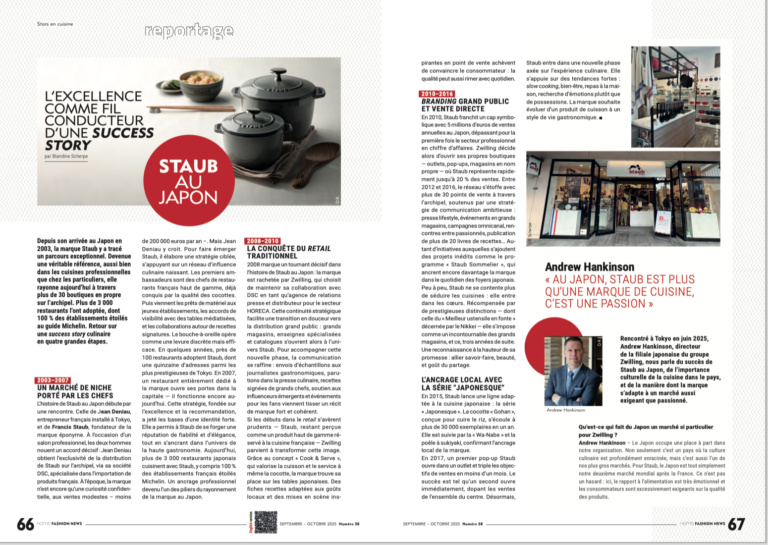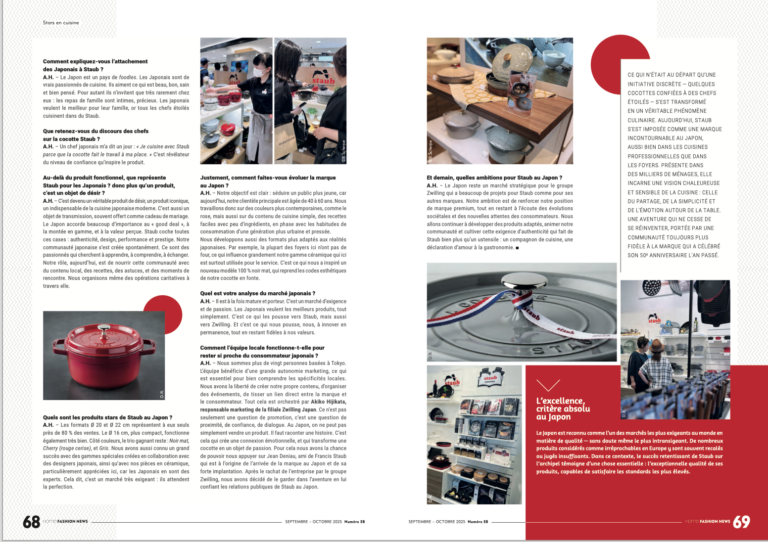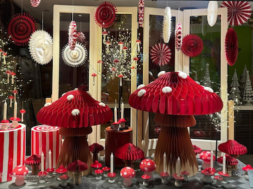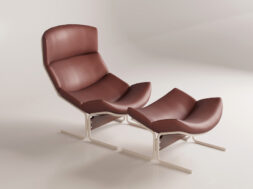
Staub Japan: Excellence as the driving force behind a success story
Since its arrival in Japan in 2003, the Staub brand has forged out an exceptional path. Having become a true benchmark, both in professional kitchens and among home cooks, it now shines through more than 30 standalone stores across the archipelago. Over 3,000 restaurants have adopted it, including 100% of Michelin-starred establishments. Let’s look back at this culinary success story in four key stages.

2003–2007 – A niche market driven by chefs
Staub’s story in Japan begins with a meeting: that of Jean Deniau, a French entrepreneur based in Tokyo, and Francis Staub, founder of the eponymous brand. At a trade show, the two men struck a decisive deal: Jean Deniau secured the exclusive distribution of Staub in Japan through his company DSC, specialized in importing fine French products. At the time, the brand was still a little-known curiosity, with modest sales — less than €200,000 per year. Yet Jean Deniau believed in it. To give Staub visibility, he devised a targeted strategy built on a budding network of culinary influencers. The first ambassadors were high-end French chefs, already convinced by the quality of Staub’s cocottes. Then came product loans to new establishments, visibility deals with high-profile restaurants, and collaborations around signature recipes. Word of mouth proved discreet but powerful. Within a few years, nearly 100 restaurants had adopted Staub, including some fifteen of Tokyo’s most prestigious addresses. In 2007, a restaurant entirely dedicated to the brand opened in the capital — and it is still running today. This strategy, rooted in excellence and recommendation, laid the foundations of a strong identity. It helped Staub earn a reputation for reliability and elegance, firmly embedding it in the world of haute gastronomie. Today, over 3,000 Japanese restaurants cook with Staub, including 100% of Michelin-starred French establishments. This professional foothold has become one of the pillars of Staub’s influence in Japan.

2008–2010 – The conquest of traditional retail
2008 marked a turning point in Staub’s history in Japan: the brand was acquired by Zwilling, which chose to maintain its collaboration with DSC as PR agency and distributor for the HORECA sector. This strategic continuity ensured a smooth transition into mainstream retail: department stores, specialty chains, and catalogs soon opened up to Staub. To support this new phase, communication was refined: product samples sent to food journalists, coverage in culinary magazines, recipes signed by top chefs, partnerships with emerging influencers, and consumer events together built a strong, coherent brand story.
Though retail beginnings were cautious — Staub was still seen as a high-end brand tied to French cuisine — Zwilling succeeded in transforming its image. With the “Cook & Serve” cocotte, which emphasized both cooking and table service, the brand gradually won over Japanese households. Recipe cards tailored to local tastes and inspiring in-store displays sealed the deal: quality could also go hand-in-hand with everyday life.
2010–2016 – Mass branding and direct sales
In 2010, Staub reached a symbolic milestone with €5 million in annual sales in Japan, surpassing professional sales for the first time. Zwilling then decided to open its own stores — outlets, pop-ups, and flagship shops — where Staub quickly accounted for up to 20% of sales. Between 2012 and 2016, the network expanded to more than 30 sales outlets across the country, supported by an ambitious communication strategy: lifestyle press, department store events, omnichannel campaigns, community meetups, and the publication of more than 20 cookbooks. These initiatives were enriched by innovative projects such as the “Staub Sommelier” program, further anchoring the brand in the daily lives of Japanese households.
Little by little, Staub no longer just won over kitchens: it won people’s hearts. Recognized with prestigious awards — including “Best Cast Iron Cookware” by Nikkei — it became a staple in department stores for three consecutive years. A recognition worthy of its promise: to unite know-how, beauty, and the joy of sharing.
Local roots with the “Japonesque” series
In 2015, Staub launched a line adapted to Japanese cuisine: the “Japonesque” series. The “Gohan” cocotte, designed to cook rice, sold over 30,000 units in a single year. It was followed by the “Wa-Nabe” and the sukiyaki pan, confirming the brand’s local roots. In 2017, Staub opened its first pop-up outlet pop-up, tripling its sales targets in less than a month. The success was such that a second one opened immediately, boosting sales for the entire center.
Now, Staub is entering a new phase focused on the culinary experience. It builds on strong consumer trends: slow cooking, wellness, home dining, and the pursuit of emotions rather than possessions. The brand aims to evolve from a cookware product into a full-fledged gastronomic lifestyle.
Andrew Hankinson – “In Japan, Staub is more than a cookware brand, it’s a passion”
Met in Tokyo in June 2025, Andrew Hankinson, Managing Director of Zwilling Japan, shares his insights on Staub’s success in Japan, the cultural importance of cuisine in the country, and how the brand adapts to a market as demanding as it is passionate.
What makes Japan such a special market for Zwilling?
Andrew Hankinson – Japan holds a unique place in our organization. Not only is it a country where culinary culture is deeply rooted, but it is also one of our biggest markets. For Staub, Japan is our second-largest market worldwide after France. It’s no coincidence: here, the relationship with food is profoundly emotional, and consumers consistently place quality above all else.
How do you explain the Japanese attachment to Staub?
A.H. – Japan is a nation of foodies. The Japanese are true cooking enthusiasts. They love what is beautiful, good, healthy, and well-designed. But they rarely improvise at home: family meals are intimate, precious moments. Japanese families want the very best — and since all Michelin-starred chefs cook with Staub, they naturally trust it.
What do chefs say about the Staub cocotte?
A.H. – A Japanese chef once told me: “I cook with Staub because the cocotte does the work for me.” That speaks volumes about the confidence the product inspires.
Beyond a functional product, what does Staub represent for the Japanese? Is it more an object of desire?
A.H. – It has become a true object of desire, an iconic product, an indispensable tool of modern Japanese cooking. It is also a symbol of transmission, often given as a wedding gift. Japan places great value on a “good deal,” on moving upmarket, and on perceived value. Staub ticks all these boxes: authenticity, design, performance, and storytelling. Our Japanese community was created spontaneously. These are passionate people who want to learn, share, and connect. Our role today is to nurture this community with local content, recipes, tips, and opportunities to meet. We even organize charity initiatives through it.
Which products are Staub’s bestsellers in Japan?
A.H. – The Ø 20 cm and Ø 22 cm formats alone represent nearly 80% of sales. The more compact Ø 16 cm also performs very well. As for colors, the winning trio remains: Matte Black, Cherry Red, and Gray. We’ve also seen great success with special editions co-created with Japanese designers, as well as with our ceramic pieces, which are highly valued here given Japanese expertise. That said, it’s a very demanding market: they expect perfection.
How are you evolving the brand in Japan?
A.H. – Our goal is clear: attract a younger audience, since our core clientele today is aged 40 to 60. We are working with more contemporary colors, such as pink, but also on simpler cooking content — easy recipes with few ingredients, suited to modern, urban lifestyles.
We are also developing formats better adapted to Japanese homes. For instance, most households don’t own ovens, which heavily influences our ceramic range, mostly used here for serving. This inspired our new 100% matte black line, which reinterprets the aesthetic codes of our cast iron cocottes.
How do you analyze the Japanese market?
A.H. – It is both mature and promising. It is a market of passion and high expectations. Japanese consumers simply want the best. That’s what draws them to Staub, and also to Zwilling. And that’s what drives us: to constantly innovate while staying true to our values.
How does the local team stay so close to Japanese consumers?
A.H. – We are a team of over twenty people based in Tokyo. The team enjoys strong marketing autonomy, essential for truly understanding local specificities. We have the freedom to create our own content, organize events, and build a direct link between the brand and consumers. All this is orchestrated by Akiko Hikata, Marketing Manager of Zwilling Japan. It’s not just about promotion — it’s about proximity, trust, and dialogue. In Japan, you can’t just sell a product: you need to tell a story. That’s what creates an emotional connection and transforms a cocotte into an object of passion. For this, we are fortunate to rely on Jean Deniau, a friend of Francis Staub who originally brought the brand to Japan and anchored its strong presence. After the acquisition by Zwilling, we chose to continue the journey by entrusting him with Staub’s PR in Japan.
And tomorrow, what ambitions does Staub have in Japan?
A.H. – Japan remains a strategic market for the Zwilling group, with many projects for Staub as for our other brands. Our ambition is to strengthen our premium positioning while staying attuned to societal changes and new consumer expectations. We will continue to develop adapted products, foster our community, and cultivate the authenticity that makes Staub more than just cookware: a genuine declaration of love for gastronomy.
Source: Home Fashion News Magazine – September 2025 (HFN58)









